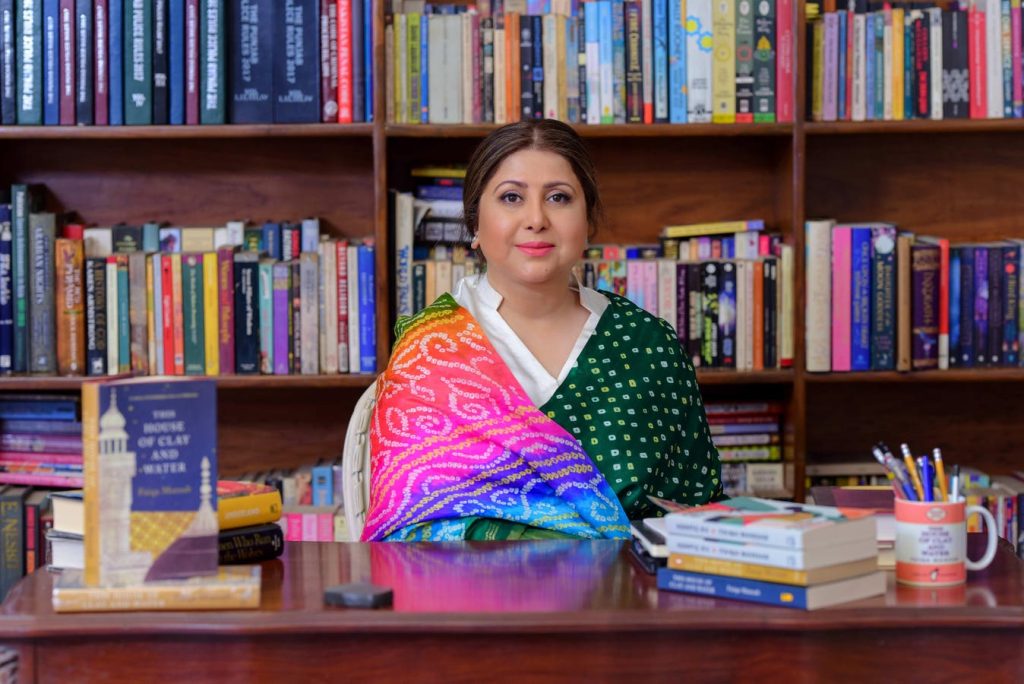Faiqa Mansab
Naeem Khan
After the success of her debut novel, This House of Clay and Water (published in 2017), Faiqa Mansab’s second novel, The Sufi Storyteller, was published by Neem Tree Press and Penguin Random House India earlier this month.
Unpretentious and soft-spoken, Mansab is a thoroughly gifted South Asian writer who is adept at weaving together layered stories, featuring complex characters that are all too human in their thoughts, dreams and longings.
For her second offering, the Pakistani author brings a thrilling murder mystery to the fore. Written in the traditional style of dastangoi (meaning storytelling in Urdu), an age-old art form of performative tale-telling, Mansab, doesn’t disappoint.
“In [The Sufi Storyteller] women are central. And not just as characters but as carriers of knowledge, keepers of stories and histories,” the author states.
In an interview with Forbes Life, Mansab speaks about both the conundrum and the delight of blending an ancient, oral art form in her newly-released book, the sacred responsibility that comes with being a writer and much more.
SR: In The Sufi Storyteller, you write about a modern-day murder, but your writing style is the traditional art of dastangoi. What inspired this fusion?
FM: I was raised in a home where stories, music, poetry and books were central to our very existence. It was my mother who first introduced me to the art of dastangoi. My mother was a great oral storyteller. She blurred the lines of history, myth and fiction when she told us stories.
Dastangoi and Sufi storytelling are deeply intertwined, I feel. My Mphil thesis was about Sufism and Sufi storytelling and I never stopped researching the topic. Sufi saints used stories, parables and allegories to teach spiritual truths. These tales were layered, open to interpretation, and meant to provoke reflection and herein lies their enduring power. Sufi stories rely on metaphor, rhythm, repetition, and lyricism, to penetrate not just the cerebral intellect but the intellect of the heart. That is itself a very Sufi perspective, the belief in the intellect of the heart and it is an incredibly powerful idea. A well-told story can by-pass defenses, plant a seed of transformation, and linger long after it has ended.
I wanted to explore how those ancient modes of storytelling could speak to our modern anxieties and the disconnection we feel in this increasingly fast-paced, digitally advancing world. At its heart, The Sufi Storyteller is about how stories save us. We tell stories to survive, to understand grief, to make sense of violence, life, loss and to connect with others. This belief, that storytelling is a communal act, inspired me.
The Sufi Storyteller, Faiqa Mansab’s second novel, published this month.
Penguin Random House India
SR: It must have been a challenge merging contemporary storytelling with a centuries old style…
FM: It was certainly a challenge, but a joy too. I think a deep respect is required for the traditions being explored. I was reinventing and re-representing both dastangoi and Sufi storytelling and I also had a willingness to be playful and experimental with these forms. Dastangoi is a performative art and cannot be replicated in writing as such. I wanted to evoke its essence – the musicality, the rhythm, the shock and pull, and layered structure, which is also a Sufi storytelling technique. Therefore, a key adaptation in form was the narrative structure.
The Sufi Storyteller does not follow linear storytelling. Instead it moves in circles. So the structure of the novel loops, returns, diverges, with story within story; some imagined by me and others retold. This wasn’t just a stylistic choice; rather, this loopy, cyclical structure reflects how we experience memory, trauma, and healing. Each minor story in the novel reveals something about the characters, or the main story plot. Sufi stories represent time as fluid, where characters transform, and the journey is the real story, not the destination.
SR: Why does The Sufi Storyteller delve into an in-depth mother-daughter relationship?
FM: That relationship is the emotional spine of the novel. For me personally, it is one of the most complex and nuanced human connections, intimate and fraught as it is with love, betrayal, resentment and longing. I have always been interested in what is bequeathed to daughters willingly and unwillingly, knowingly or otherwise. So, this exploration felt inevitable, especially through the lens of mysticism and murder.
“I have always held that writing is a sacred act, hence, it is a sacred responsibility too.” – Faiqa Mansab
Naeem Khan
SR: Having received significant critical acclaim (including being optioned for screen adaptation) how did your debut novel shape your journey as a writer?
FM: Writing for me then was a way of claiming my voice. Perhaps claiming space as a writer, a woman from Pakistan, who did not want to conform to expected narratives and did not have powerful relations and connections in the publishing and literary world. I wrote This House of Clay and Water with urgency and honesty, not really thinking about how it would be received, but more focused on writing the kind of story I wanted to read: layered, emotionally resonant, and unafraid of discomfort.
The critical acclaim and the screen adaption interest were of course validating. But more than that, the response made me realize that there is a hunger for stories that complicate stereotypes, that challenge accepted binaries. That realization helped me trust myself as a writer. Another significant development after my debut was my relationship with my readers. I was humbled – am humbled – at the number of readers both men and women reached out to me to share how the novel resonated with them. I have always held that writing is a sacred act, I realized then that it is a sacred responsibility too. What matters most to me, also matters to my readers: authenticity and honesty, and the transformative power of story. Every quiet sentence I have written is rooted in this act of faith.

